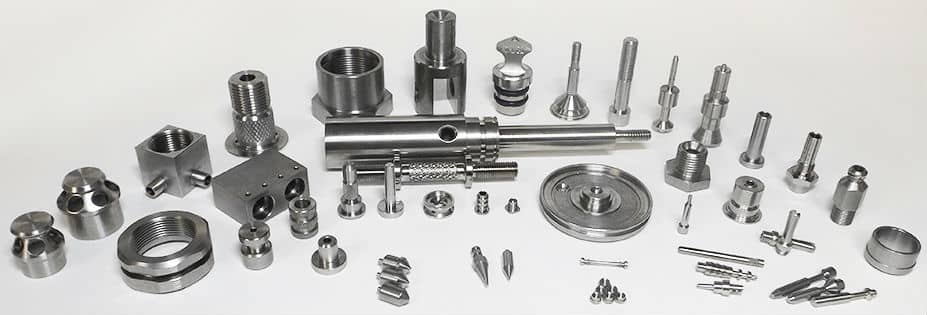What milling cutter is used for machining stainless steel? This is a problem that many people often encounter. If customers encounter problems such as chipping and work hardening when machining stainless steel. This article combines 18 years of industry experience and relevant professional information of SANS Machining to solve this problem for you.
Stainless Steel Milling Features
Compared with the workability of 45# steel, the workability of austenitic stainless steel is only 0.4, ferritic stainless steel is only 0.48, and martensitic stainless steel is only 0.55. Among them, the workability of austenite and carbonite mixture is worse.
1. Severe Work Hardening
The work hardening of stainless steel is serious. The first choice is the mixture of austenite and ferrite. The hardness of the hardened layer is 1.4~2.2 times higher than the original matrix hardness, and the strength is R=1470~1960MPa. This type of stainless steel has a large plasticity and a large strengthening coefficient. Moreover, austenite is unstable and easily transforms into martensite under the action of cutting force.
2. Large Cutting Force
Stainless steel has high plasticity, especially the depth rate of austenitic stainless steel is 2.5 times that of 45# steel. In the process of milling, the plastic deformation is large, the cutting force is increased, the work hardening is serious, the thermal strength is high, and the cutting curl and break are difficult.
3. High Cutting Temperature
Stainless steel has large plastic deformation, increased friction, and its thermal conductivity is relatively low. Therefore, under the same conditions, the temperature of milling stainless steel is about 200 degrees higher than that of No. 45 steel.

4. Cutting Is Not Easy To Break
When processing stainless steel, it is easy to bond and produce built-up edge. The plasticity and toughness of stainless steel are relatively large, and it is not easy to break when milling. Under high temperature and high pressure, the tool is prone to adhesive wear and built-up edge.
5. The Tool Is Easy To Wear
Of course, stainless steel milling cutters must be used to process stainless steel, because the TiC hard point of stainless steel is likely to cause violent grinding and wear of the tool. Under high-speed, high-temperature and high-pressure conditions, cutting and cutting tools are prone to adhesion, diffusion and crater wear.
What Milling Cutter Is Used For Machining Stainless Steel?
When do stainless steel machining, it is best to choose a material with high hardness, good wear resistance, strength and toughness, and good thermal conductivity.
Cemented carbide materials: YG and YW, etc. Use TaC or NbC-containing tungsten-cobalt fine-grained or ultra-fine-grained cemented carbide. Such as YG6x, YG813, YW4, YD15 and so on.
High-speed steel materials: W6Mo5Cr4V2Al, W10Mo4CrV3Al, etc.
For milling ordinary stainless steel materials such as 201 and 304, use ordinary carbide-coated milling cutters and choose 4 blades to mill well. Secondly, all major CNC tool suppliers have special stainless steel milling cutters. If customers are not sensitive to prices, they can choose this type of cutter. If machining 316 stainless steel, stainless steel after quenching and heat treatment, imported and high-hardness stainless steel, in addition to using high-hardness knives, the cutting edges of stainless steel must be sharper, and it is best to use special stainless steel knives from various well-known brands.
Reasonable Cutting Parameters For Stainless Steel Machining
Stainless steel processing can be divided into rough machining and finishing. Rough machining can choose YW and YT cemented carbide with relatively low TiC content. For finishing, you can choose YW and YT cemented carbide with high TiC content. .
Secondly, in order to prevent edge chipping in processing stainless steel, the strength of the blade should be increased, and the rake angle is best to choose a smaller value or a negative value. If hard alloy is used for processing stainless steel, the helix angle is preferably 5-10 degrees. If high-speed steel end mills are used, 35-45 degrees should be selected. When milling stainless steel, it is best to choose an end mill with a larger helix angle, and when milling stainless steel pipes or thin-walled workpieces, you can choose a corn end mill.
Commonly used stainless steel milling consumption
For hard alloy stainless steel milling cutters, the milling speed should be 40-60m/min. In order to avoid cutting edges in the hardened layer and accelerate tool wear, the feed rate should be greater than 0.1mm.
High-speed steel end mills, cutting speed 8-40m/min, feed rate 0.013~0.15mm/z.

Other Knowledge Of Machining Stainless Steel
- For machininghigh-hardness stainless steel, it is best not to use high-speed steel end mills.
- If the hardness of the steel is higher, choose a lower milling amount.
- When the amount of side tool is large, choose a lower milling speed.
- Using coated carbide cutting tools, the milling speed can be increased by about 50%.
- When cutting, pay attention to fully cooling off. If you use cemented carbide tools to process stainless steel, do not use water-soluble cutting fluids to avoid the cutting edge from being subjected to greater thermal stress and causing chipping.


